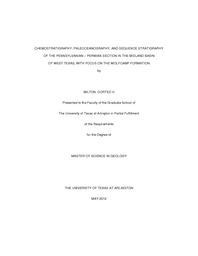| dc.description.abstract | The late Pennsylvanian to early Permian rocks (Wolfcampian and Leonardian) of the Midland Basin represent a single lithologic unit composed primarily of calcareous mudrocks, siliceous mudrocks, muddy carbonate-clast conglomerates, and skeletal packstones/grainstones at the approximate depositional center located in Reagan County, Texas. Pure versions of these lithologic end-members are discretely distributed among a multitude of transitional lithofacies. The Midland Basin evolved in the foreland of the Ouachita Fold-belt from Mississippian to early Permian time along-side several sub-basins of the Permian Basin. These basins were formed by disseverance and uplift associated with the continental collision of Laurasia and Gondwana to form Pangea in the Late Paleozoic. Wolfcampian and Leonardian clastics were deposited into the basin as a result of a rapid increase in accommodation due to basin subsidence and proximal uplift of the Central Basin Platform, in concurrence with glacially-driven eustatic sea-level fluctuations influenced by the Late Paleozoic Ice Age (LPIA). Various aspects of Penn-Perm strata that were studied include degree of basin restriction, redox conditions, sediment input, paleoceanography, bulk geochemistry, and sequence stratigraphy. Four drill cores located in Reagan and Martin Counties were scanned at a 1-foot interval with a hand-held energy-dispersive x-ray fluorescence (HH-ED-XRF) spectrometer to provide quantitative analysis of major (e.g. Fe, Si, Al) and trace (e.g. Mo, Cr, V) elements. In addition, total organic carbon (TOC), total inorganic carbon (TIC), X-Ray Diffraction (XRD) spectroscopy, and stable isotopes of organic carbon (δ13Corg) were analyzed in two of the cores. Focus of the project was to thoroughly define the chemostratigraphy of a continuous core through the Leonardian and Wolfcampian strata in Reagan County. Secondarily, study of intermittent core through the Spraberry, Dean, Strawn, and Atoka Formations in the Martin County core provided insight into the overall evolution of the Midland Basin from Atokan to the Guadalupian time. The area of study is located off of the shelf slope into marginal basin settings, and is oriented parallel to the Eastern Shelf between the Ozona Arch and the Eastern Shelf Nose. The physical paleoceanography of the Penn-Perm section reveals an overall high degree of basin restriction at the time of deposition, while large scale study revealed an overarching trend of basin deepening along-side an increase in primary production seen in several scales of cyclic stair-stepping negative δ13Corg excursions. Fluctuations in the degree of restriction and water mass mixing were studied through the chemical paleoceanographic interpretation of several distinct zones enriched in redox sensitive trace metals (Mo, V, Ni, and Zn) and/or detrital sediments (Ca, Fe, Si, Mg, and K) normalized to clay. Individual zones labeled Detrital (DZ), Detrital-Anoxic (DAZ), and Anoxic (AZ) were linked to changes in basin dynamics and ultimately associated with a complete LPIA-driven lowstand-to-highstand sequence stratigraphic cycle. Ultimately, a thorough chemostratigraphy was developed on Late Pennsylvanian through Permian age mudrocks. Correlations between chemostratigraphy, paleoceanography, and sequence stratigraphy have enhanced the ability to assess the economic potential of Midland Basin Penn-Perm rocks as an unconventional source/reservoir. Furthermore, the study has laid the groundwork for future attempts to make similar correlations between mudrock geochemistry to marine basin dynamics. | en_US |

